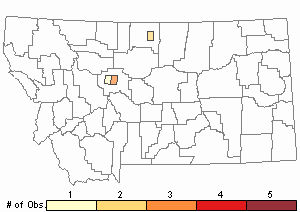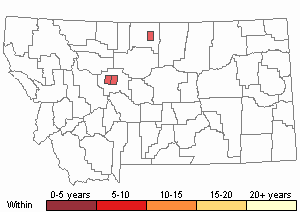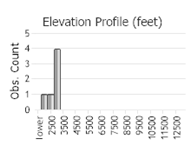View in other NatureServe Network Field Guides
NatureServe
Montana
Utah
Wyoming
Idaho
Wisconsin
British Columbia
South Carolina
Yukon
California
New York
Blowout Tiger Beetle - Cicindela lengi
Native Species
Global Rank:
G5
State Rank:
S4
Agency Status
USFWS:
USFS:
BLM:
External Links
General Description
The following comes from Pearson et al. (2015). Body length is 12-15 mm. Red to reddish-brown above (dark maroon, green or blue in Canada). Maculations wide and usually connected along margins of elytra, the front (shoulder) maculation angles away from margin in a straight line with no hook at posterior end. Underside of abdomen metallic green to blue-green with dense white hairs, thorax green or blue to coppery.
Phenology
Tiger beetle life cycles fit two general categories based on adult activity periods. “Spring-fall” beetles emerge as adults in late summer and fall, then overwinter in burrows before emerging again in spring when mature and ready to mate and lay eggs. The life cycle may take 1-4 years. “Summer” beetles emerge as adults in early summer, then mate and lay eggs before dying. The life cycle may take 1-2 years, possibly longer depending on latitude and elevation (Kippenhan 1994, Knisley and Schultz 1997, Leonard and Bell 1999). Adult Cicindela lengi spring-fall species, April to October but mostly May to July, with stragglers September to October (Criddle 1907, Carter 1989, Kippenhan 1994, Acorn 2001, Larochelle and Larivière 2001, Pearson et al. 2015). In Montana, adults appear by at least mid-May, again August to mid-September (Nate Kohler personal communication).
Diagnostic Characteristics
The following is largely taken from Pearson et al. (2015). Differs from the similarly colored and sometimes sympatric
Big Sand Tiger Beetle (
C. formosa) by its narrower and smaller size, longer and narrower labrum, and the front (shoulder) maculation is relatively longer. The
Oblique-lined Tiger Beetle (
C. tranquebarica) is darker above with thinner shoulder maculations, The
Crimson Saltflat Tiger Beetle (
C. fulgida) is smaller, much shinier above, and occurs in moist alkaline soils of salt flats or river and lake edges, not dry sandy areas.
Species Range
Montana Range
Range Descriptions

 Native
Native
Range Comments
Largely a prairie species, from northern Alberta and Saskatchewan, and southwestern Manitoba, to northern Arizona and New Mexico and southern Kansas (Pearson et al. 2015). In Montana, found in the plains east of the Continental Divide; from the Missouri River to Canada and along the borders with the Dakotas and northern Wyoming; occurrence unclear in the central part of the state south of the Missouri River (Pearson et al. 2015, Nate Kohler personal communication).
Observations in Montana Natural Heritage Program Database
Number of Observations: 7
(Click on the following maps and charts to see full sized version)
Map Help and Descriptions
Relative Density

Recency



 (Observations spanning multiple months or years are excluded from time charts)
(Observations spanning multiple months or years are excluded from time charts)
Migration
Non-migratory but capable of dispersal. When wings fully developed (macropterous), a good but short-distance flier and fast runner (Larochelle and Larivière 2001).
Habitat
Adult and larval tiger beetle habitat is essentially identical. The larvae live in soil burrows (Knisley and Schultz 1997). Across the range Cicindela lengi prefers open spaces in dry upland sandy areas with moderate to sparse amounts of vegetation, margins of blowouts, sandy road cuts, sand ridges through open coniferous forest, sandy beaches, eroded banks along dry watercourses, sand flats, and sometimes open gravel patches in short grass without sand (Vaurie 1950, Wallis 1961, Hooper 1969, Carter 1989, Acorn 2001, Larochelle and Larivière 2001, Kritsky and Smith 2005, Pearson et al. 2015). In Montana, found in sand hills, blowouts, sandy banks and beaches along water courses (Nate Kohler personal communication).
Food Habits
Larval and adult tiger beetles are predaceous. In general, both feed considerably on ants (Wallis 1961, Knisley and Schultz 1997). Adult C. lengi reported to feed on ants (Larochelle and Larivière 2001), and probably other small insects and spiders.
Ecology
Larval tiger beetles live in burrows and molt through three instars to pupation, which also occurs in the larval burrow. Adults make shallow burrows in soil for overnight protection, deeper burrows for overwintering. Adults are sensitive to heat and light and most active during sunny conditions. Excessive heat during midday on sunny days drives adults to seek shelter among vegetation or in burrows (Wallis 1961, Knisley and Schultz 1997).
Cicindela lengi has a narrow range of ecological tolerance (stenotopic). Larval burrows are found in low densities in sandy soils on both flats and slopes (Pearson et al. 2015), and are up to 137 cm deep. Adults overwinter in burrows 30-80 cm deep. Adults are diurnal, gregarious, and seek shade in vegetation to escape hot sunshine. Predators include asilid (robber) flies. Remain close to cover, escapes pursuit by flying quickly in straight line up to 5 m. Other associated tiger beetle species include
Big Sand Tiger Beetle (
C. formosa),
Badlands Tiger Beetle (
C. decemnotata), and
Boreal Long-lipped Tiger Beetle (
C. longilabris) (Vaurie 1950, Acorn 2001, Larochelle and Larivière 2001).
Reproductive Characteristics
The life cycle of Cicindela lengi is 3-4 years, depending on latitude, probably 2-3 years as larvae in the north (Acorn 2001, Larochelle and Larivière 2001). Mating reported in June. Larval burrows average 112.5 cm deep, overwinter in burrows 70-137 cm deep (Larochelle and Larivière 2001). No information for Montana.
Management
Not considered rare or in need of special conservation management (Knisley et al. 2014). Sandy habitats favored by this species experience vegetation encroachment and stabilization as succession proceeds, and benefit from disturbance that retains a mosaic of successional conditions. Some colonies (particularly the larval burrows) could be impacted by trampling through livestock overgrazing, but grazing at appropriate times and stocking levels could also be beneficial by keeping vegetation cover more open (Knisley 2011). Prescribed fire in late autumn could also be a useful tool for sustaining habitat once larvae and adults are in overwinter burrows.
Stewardship Responsibility
References
- Literature Cited AboveLegend:
 View Online Publication
View Online Publication Acorn, J. 2001. Tiger beetles of Alberta: killers on the clay, stalkers on the sand. The University of Alberta Press, Edmonton, Alberta. 120 p.
Acorn, J. 2001. Tiger beetles of Alberta: killers on the clay, stalkers on the sand. The University of Alberta Press, Edmonton, Alberta. 120 p. Carter, M. R. 1989. The biology and ecology of the tiger beetles (Coleoptera: Cicindelidae) of Nebraska. Transactions of the Nebraska Academy of Sciences XVII: 1-18.
Carter, M. R. 1989. The biology and ecology of the tiger beetles (Coleoptera: Cicindelidae) of Nebraska. Transactions of the Nebraska Academy of Sciences XVII: 1-18. Criddle, N. 1907. Habits of some Manitoba 'tiger beetles' (Cicindela). Canadian Entomologist 39:105-114.
Criddle, N. 1907. Habits of some Manitoba 'tiger beetles' (Cicindela). Canadian Entomologist 39:105-114. Hooper, R.R. 1969. A review of Saskatchewan tiger beetles. Cicindela 1(4):1-5.
Hooper, R.R. 1969. A review of Saskatchewan tiger beetles. Cicindela 1(4):1-5. Kippenhan, Michael G. 1994. The Tiger Beetles (Coleoptera: Cicindelidae) of Colorado. 1994. Transactions of the American Entomological Society 120(1):1-86.
Kippenhan, Michael G. 1994. The Tiger Beetles (Coleoptera: Cicindelidae) of Colorado. 1994. Transactions of the American Entomological Society 120(1):1-86. Knisley, C.B. 2011. Anthropogenic disturbances and rare tiger beetle habitats: benefits, risks, and implications for conservation. Terrestrial Arthropod Reviews 4:41-61.
Knisley, C.B. 2011. Anthropogenic disturbances and rare tiger beetle habitats: benefits, risks, and implications for conservation. Terrestrial Arthropod Reviews 4:41-61. Knisley, C.B., and T.D. Schultz. 1997. The biology of tiger beetles and a guide to the species of the south Atlantic states. Virginia Museum of Natural History Special Publication Number 5. 210 p.
Knisley, C.B., and T.D. Schultz. 1997. The biology of tiger beetles and a guide to the species of the south Atlantic states. Virginia Museum of Natural History Special Publication Number 5. 210 p. Knisley, C.B., M. Kippenhan, and D. Brzoska. 2014. Conservation status of United States tiger beetles. Terrestrial Arthropod Reviews 7:93-145.
Knisley, C.B., M. Kippenhan, and D. Brzoska. 2014. Conservation status of United States tiger beetles. Terrestrial Arthropod Reviews 7:93-145. Kohler, Nathan S. Excel spreadsheets of tiger beetle observations. 6 August 2022.
Kohler, Nathan S. Excel spreadsheets of tiger beetle observations. 6 August 2022. Kritsky, G. and J. Smith. 2005. Teddy's tigers: the Cicindelidae (Coleoptera) of Theodore Roosevelt National Park, North Dakota. Cicindela 37(1-2):1-16
Kritsky, G. and J. Smith. 2005. Teddy's tigers: the Cicindelidae (Coleoptera) of Theodore Roosevelt National Park, North Dakota. Cicindela 37(1-2):1-16 Larochelle, A and M Lariviere. 2001. Natural history of the tiger beetles of North America north of Mexico. Cicindela. 33:41-162.
Larochelle, A and M Lariviere. 2001. Natural history of the tiger beetles of North America north of Mexico. Cicindela. 33:41-162. Leonard, Jonathan G. and Ross T. Bell, 1999. Northeastern Tiger Beetles: a field guide to tiger beetles of New England and eastern Canada. Boca Raton, FL: CRC Press. 176 p.
Leonard, Jonathan G. and Ross T. Bell, 1999. Northeastern Tiger Beetles: a field guide to tiger beetles of New England and eastern Canada. Boca Raton, FL: CRC Press. 176 p. Pearson, D.L., C.B. Knisley, D.P. Duran, and C.J. Kazilek. 2015. A field guide to the tiger beetles of the United States and Canada, second edition. New York, NY: Oxford University Press. 251 p.
Pearson, D.L., C.B. Knisley, D.P. Duran, and C.J. Kazilek. 2015. A field guide to the tiger beetles of the United States and Canada, second edition. New York, NY: Oxford University Press. 251 p. Vaurie, P. 1950. Notes on the habitats of some North American tiger beetles. Journal of the New York Entomological Society 58(3):143-153.
Vaurie, P. 1950. Notes on the habitats of some North American tiger beetles. Journal of the New York Entomological Society 58(3):143-153. Wallis, J.B. 1961. The Cicindelidae of Canada. Toronto, Ontario, Canada: University of Toronto Press. 74 p.
Wallis, J.B. 1961. The Cicindelidae of Canada. Toronto, Ontario, Canada: University of Toronto Press. 74 p.
- Additional ReferencesLegend:
 View Online Publication
View Online Publication
Do you know of a citation we're missing? Bousquet, Yves. 2012. Catalogue of Geadephaga (Coleoptera; Adephaga) of America north of Mexico. ZooKeys. 245:1-1722.
Bousquet, Yves. 2012. Catalogue of Geadephaga (Coleoptera; Adephaga) of America north of Mexico. ZooKeys. 245:1-1722. Pearson, D.L., C.B. Knisley, and C.J. Kazilek. 2006. A field guide to the tiger beetles of the United States and Canada: identification, natural history, and distribution of the Cicindelidae. Oxford University Press, New York, New York. 227 pp.
Pearson, D.L., C.B. Knisley, and C.J. Kazilek. 2006. A field guide to the tiger beetles of the United States and Canada: identification, natural history, and distribution of the Cicindelidae. Oxford University Press, New York, New York. 227 pp.
- Web Search Engines for Articles on "Blowout Tiger Beetle"
- Additional Sources of Information Related to "Insects"





